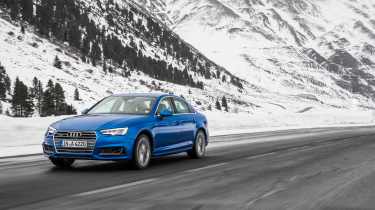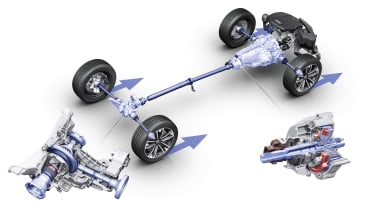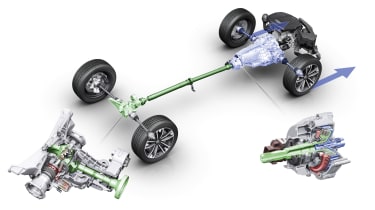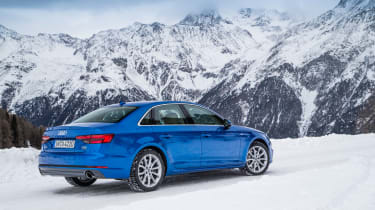Will Audi's new fuel efficient quattro system feature on future RS models?
Quattro with ultra technology is Audi's updated 4WD system with an eye to economy
When new technology appears on performance cars, it has usually been filtered down through motorsport. Carbon ceramic brakes, paddle shift gearboxes and carbonfibre chassis to name just a few.
When it comes to Audi’s famous quattro four-wheel drive system, something you traditionally associate with performance, future plans are a little less exciting. The next generation of quattro is going to be all about economy.
Quattro with ultra technology is the name Audi has given to its new all-wheel-drive system, and it will be eventually making its way to all its longitudinally mounted front-engined cars. With a focus solely on economy, it certainly isn’t going to help Audi reestablish itself as a dominant force in rallying but there are elements we’re likely to see on S and RS Audis in the future.
So how does it work? In short, the latest Quattro update tries to improve fuel economy by making all-wheel drive Audis just front-wheel drive when you simply don't need the extra traction.
In normal driving, a new multi-plate clutch at the back of the gearbox completely decouples the propshaft that runs to the rear diff. This new clutch pack replaces the standard quattro system's self-locking centre mechanical differential. The clutch pack is actually a Haldex unit similar to the one found on the rear axle of the RS3 and TT. It can also re-engage the propshaft seamlessly, and almost instantly, whenever four-wheel drive is needed.
Just disconnecting the propshaft from the gearbox would reduce mechanical drag and improve fuel efficiency. But to improve fuel economy even further, Audi has developed a system that decouples one of the driveshafts from the diff with the use of dog clutches. This allows one wheel and driveshaft to spin on independently of the rear differential. As there is no locking element to the rear diff, the opposite drive shaft only spins the planet gears but doesn’t spin the diff carrier, crown wheel and propshaft. When the rear axle is needed, the driveshaft is re-engaged moments before the Haldex unit engages the proshaft.
Audi never wants its quattro cars to serve up just front-wheel drive when the driver expects the traction of all wheel drive. It has gone to huge lengths to develop systems that can ‘predict’ when four-wheel drive is needed. Quattro with ultra technology relies on a multitude of sensors and data to guess when four-wheel drive might be necessary. The onboard computer monitors driver inputs, including steering and throttle. It also takes into consideration what driving mode you’re in and whether you’ve selected a gear manually.
It uses this data, not only to decide when to engage the rear wheels, but also build a profile of the sort of driver you are. It also monitors external conditions like temperature and will learn grip levels.
The system will also react if it detects any loss of grip front the front axle. However, the vast amount of information being processed means that you already have 4WD in situations where front-wheel drive would be insufficient. None of that sounds that very sporty, and the mere mention of the word Haldex will be more than enough to put some people off. But it’s the Haldex unit that could be one of the parts from the new quattro system we’ll see on Audi’s performance cars. The Haldex clutch pack not only decouples the propshaft but it also distributes varying amounts of torque to each axle.
The centre locking diff currently used in quattros does the same thing, but the new Haldex system allows the S-tronic gearbox to be more simple and lighter. In fact, despite the complicated rear propshaft, quattro with ultra technology is 4kg lighter than the basic quattro system – mostly thanks to the lighter gearbox.
For a performance application, the clutch pack wouldn’t be used to decouple drive to the rear axle, but as it’s able to do a similar job to the current self-locking centre differential and is lighter, there’s good reason to implement it in S and RS Audis.
The complicated system used to determine when four-wheel drive is required is another part that we can see being implemented on all quattro Audis. Not just the RS4, S5 and other models with longitudinal front engines, but all Quattro-equipped Audis including the R8. The system doesn’t just decide when to engage the rear axle, it also guesses which axle will need the most torque – the Haldex unit distributing how much is needed, and where. The current systems in performance Audis instead react to changes in wheel speed and grip.
Adding the clever predictive system from the new quattro with ultra technology could send torque exactly when and where it’s needed. Combine this with Audi’s sport differential, a torque-distributing differential on the rear axle, and it could send torque to a specific wheel rather than just a whole axle. And as the system can learn what sort of driver you are, it could potentially use this specific torque distribution to help adapt the car to your style of driving.
Conventional wisdom suggests that economical cars have nothing to offer the world of performance cars. But if some of the systems that go into Quattro with ultra technology end up in performance Audis the results could be promising.








